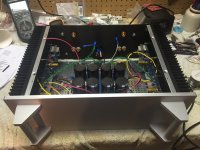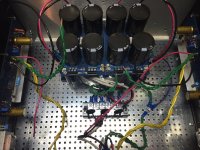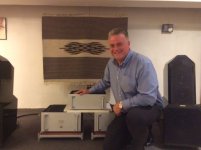Quad '63's were Not 'wunnerfull' speakers.
Regardless of what you may have been told ..Or.. led to believe.
Stick any old Amp to them and enjoy.
Regardless of what you may have been told ..Or.. led to believe.
Stick any old Amp to them and enjoy.
Bare, what do you mean by 'wunnerfull'?
The Quads have a midrange that is hard to beat. They image like no other. They will not play very loud, if pushed will arc and will play less loudly every time they arc.
Not much low bass, but it is a good mid-bass.
I could live with a good newish pair, but there are no newish pairs any more, they have arced and degraded over all these years.
Rush
Bare, what do you mean by 'wunnerfull'?
Ones I've heard were crispy but also thin sounding.
Their sounds soon wore on me.
Add in the infamous Quad reliability/lifespan issues and IMO a Speaker best enjoyed in someone else's system 😉
Having finished F-6 in the Deluxe 4U chassis, I can tell all that it is more than adequate for this amplifier. At standard bias, it is just warm. Going higher it is still good.
It is indeed smaller than the 5U I built BA-3 in and I wondered, but F-6 does not appear to be as hot as some Pass amps. While considerably smaller that 5U, it is just fine, not borderline, but fine.
Russellc
According to Papa, the Aleph J dissipates 200 watts at idle, the F6 180 watts. The build guide cites the Deluxe 4U chassis as just adequate for the Aleph J. The F6 seems to run cooler than the 20 watts difference between it and the Aleph J would seem to indicate. How much heatsink do I need for my F6? 😕
dissipation is always Iq x both rails , then double for two channels in case
plus some losses in Donut , plus some losses in Graetz bridges and some losses in CRC filter
Papa is always drawing pictures with broad strokes , being precise only when it's really necessary
so - 200W for Aleph J is somewhat exaggerated figure
plus some losses in Donut , plus some losses in Graetz bridges and some losses in CRC filter
Papa is always drawing pictures with broad strokes , being precise only when it's really necessary
so - 200W for Aleph J is somewhat exaggerated figure
Papa is always drawing pictures with broad strokes , being precise only when it's really necessary
so - 200W for Aleph J is somewhat exaggerated figure
Measured my Aleph J draws 190W and runs quite hot. F4 is much cooler. Not sure about F6.
that's not counting
I was speaking about original J , just to stay in context/perspective
on the other hand - Papa is teaching us all the time to use brain , so Aleph (J) is more state of mind , than thing carved in stone

I was speaking about original J , just to stay in context/perspective
on the other hand - Papa is teaching us all the time to use brain , so Aleph (J) is more state of mind , than thing carved in stone

Measured my Aleph J draws 190W and runs quite hot. F4 is much cooler. Not sure about F6.
I've had an Aleph 30 and BA3 and you will notice they both have more output mosfets than the F6. The F6 runs a lot cooler depending on bias of course.
New toy.

First THD at 1000mA bias (1kHz/1W/8R) = 0.020%, not too bad...?
2nd and 3rd harmonics nice and even. No other harmonics.
Still lots to do to make it perfect though...
NE5534 preamp,
diamond buffer, (BC550/560, BD137/138)
LL1540
BD135 drivers
IRFP140 outputs

First THD at 1000mA bias (1kHz/1W/8R) = 0.020%, not too bad...?
2nd and 3rd harmonics nice and even. No other harmonics.
Still lots to do to make it perfect though...
NE5534 preamp,
diamond buffer, (BC550/560, BD137/138)
LL1540
BD135 drivers
IRFP140 outputs
Folks:
My friend Tim came by for a listening session six months or so ago and promptly decided he wanted to replace his commercial stereo, so we embarked on an F6 build. I organized the BOM, selected the parts and their sources and made him do all of the work. He lives 400 miles away so our build sessions were sporadic, but when he was in town he'd swing by for an evening's work. I pretty much stood behind him as he soldered at my workbench. That amp was completed last night and sounds terrific.
We did encounter one problem: a few of the parts we used were pulled from my inventory, including the fuses. I didn't have any 2.5 amp slow-blow fuses, so we used a 2 amp fuse that lasted all of 1.5 seconds before frying. The next smallest value I had on hand was 4 amps, which naturally worked. I'd like to verify that there isn't a safer value for Tim's amp. We deviated from Nelson's design in the power supply: we used an Antek AS-4218 toroid and eight 22,000 uF Panasonic TSHA caps (176,000 uF in total). Everything else was stock (Store F6 and PS pcbs, 4U Deluxe chassis, etc.).
Can someone explain how to calculate the proper fuse value for Tim's amp?
Regards,
Scott
My friend Tim came by for a listening session six months or so ago and promptly decided he wanted to replace his commercial stereo, so we embarked on an F6 build. I organized the BOM, selected the parts and their sources and made him do all of the work. He lives 400 miles away so our build sessions were sporadic, but when he was in town he'd swing by for an evening's work. I pretty much stood behind him as he soldered at my workbench. That amp was completed last night and sounds terrific.
We did encounter one problem: a few of the parts we used were pulled from my inventory, including the fuses. I didn't have any 2.5 amp slow-blow fuses, so we used a 2 amp fuse that lasted all of 1.5 seconds before frying. The next smallest value I had on hand was 4 amps, which naturally worked. I'd like to verify that there isn't a safer value for Tim's amp. We deviated from Nelson's design in the power supply: we used an Antek AS-4218 toroid and eight 22,000 uF Panasonic TSHA caps (176,000 uF in total). Everything else was stock (Store F6 and PS pcbs, 4U Deluxe chassis, etc.).
Can someone explain how to calculate the proper fuse value for Tim's amp?
Regards,
Scott
Attachments
Folks:
My friend Tim came by for a listening session six months or so ago and promptly decided he wanted to replace his commercial stereo, so we embarked on an F6 build. I organized the BOM, selected the parts and their sources and made him do all of the work. He lives 400 miles away so our build sessions were sporadic, but when he was in town he'd swing by for an evening's work. I pretty much stood behind him as he soldered at my workbench. That amp was completed last night and sounds terrific.
We did encounter one problem: a few of the parts we used were pulled from my inventory, including the fuses. I didn't have any 2.5 amp slow-blow fuses, so we used a 2 amp fuse that lasted all of 1.5 seconds before frying. The next smallest value I had on hand was 4 amps, which naturally worked. I'd like to verify that there isn't a safer value for Tim's amp. We deviated from Nelson's design in the power supply: we used an Antek AS-4218 toroid and eight 22,000 uF Panasonic TSHA caps (176,000 uF in total). Everything else was stock (Store F6 and PS pcbs, 4U Deluxe chassis, etc.).
Can someone explain how to calculate the proper fuse value for Tim's amp?
Regards,
Scott
3AG slow blow type 2 1/2 amp for 120VAC
Straight from the F6 manual. I usually just use a 3 amp. If there is a serious problem a 3 amp is going to blow. The 2 1/2 amp is not as easy to find as a 3 amp.
The 2 1/2 amp is not as easy to find as a 3 amp.
I've purchased a ton of 2.5A slo-blo fuses in both glass and ceramic bodies.
They're out there.
Nice work! That's a happy guy! 😉
Best,
Vince
Folks:
My friend Tim came by for a listening session six months or so ago and promptly decided he wanted to replace his commercial stereo, so we embarked on an F6 build. I organized the BOM, selected the parts and their sources and made him do all of the work. He lives 400 miles away so our build sessions were sporadic, but when he was in town he'd swing by for an evening's work. I pretty much stood behind him as he soldered at my workbench. That amp was completed last night and sounds terrific.
We did encounter one problem: a few of the parts we used were pulled from my inventory, including the fuses. I didn't have any 2.5 amp slow-blow fuses, so we used a 2 amp fuse that lasted all of 1.5 seconds before frying. The next smallest value I had on hand was 4 amps, which naturally worked. I'd like to verify that there isn't a safer value for Tim's amp. We deviated from Nelson's design in the power supply: we used an Antek AS-4218 toroid and eight 22,000 uF Panasonic TSHA caps (176,000 uF in total). Everything else was stock (Store F6 and PS pcbs, 4U Deluxe chassis, etc.).
Can someone explain how to calculate the proper fuse value for Tim's amp?
Regards,
Scott
My F6 uses 8 x 33,000 and 2.5A or 3A work fine. CL-60 slow start, per first watt power supplies. My BA3 amp, same 8 x 33,000 power supply does too, but it uses the store's slow start. Same fuses since build completed in both. 2.5A was specified for stock supply, I figure if they blew on start up, I would just creep up until they didn't.
I inquired about this during my BA3 build, and I think Andrew responded with such a formula?
Russellc
Last edited:
Folks:
My friend Tim came by for a listening session six months or so ago and promptly decided he wanted to replace his commercial stereo, so we embarked on an F6 build. I organized the BOM, selected the parts and their sources and made him do all of the work. He lives 400 miles away so our build sessions were sporadic, but when he was in town he'd swing by for an evening's work. I pretty much stood behind him as he soldered at my workbench. That amp was completed last night and sounds terrific.
We did encounter one problem: a few of the parts we used were pulled from my inventory, including the fuses. I didn't have any 2.5 amp slow-blow fuses, so we used a 2 amp fuse that lasted all of 1.5 seconds before frying. The next smallest value I had on hand was 4 amps, which naturally worked. I'd like to verify that there isn't a safer value for Tim's amp. We deviated from Nelson's design in the power supply: we used an Antek AS-4218 toroid and eight 22,000 uF Panasonic TSHA caps (176,000 uF in total). Everything else was stock (Store F6 and PS pcbs, 4U Deluxe chassis, etc.).
Can someone explain how to calculate the proper fuse value for Tim's amp?
Regards,
Scott
I'm using 1.5A slow blow fuses on the 240V AC mains without issue.
Based on my results a 3A slow blow should certainly work on 120V AC.
Are you using the thermistor soft start?
It's cerainly not hard to calculate mains current if you know your secondary transformer voltages and currents, however I'm extremely lazy to write out the procedure.
I'm sure you can work it out.
- Home
- Amplifiers
- Pass Labs
- F6 Amplifier


